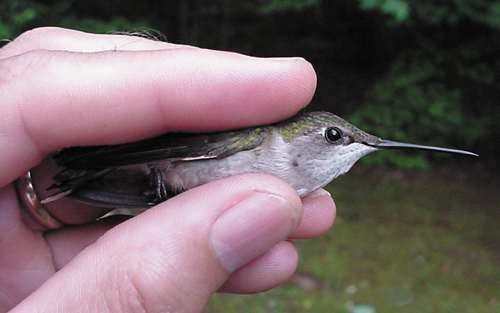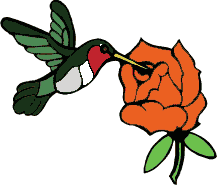|
|
|||
|
THIS WEEK at HILTON POND |
|
The federal Bird Banding Lab in Laurel, Maryland is understandably judicious in awarding hummingbird banding authorizations. Banding hummingbirds is both an art and a science, especially since the bander has to form each tiny band from a thin sheet of aluminum onto which numbers have been photoengraved (below left). This tedious procedure, if done improperly, results in a poorly rendered band that may injure the hummingbird's exceedingly short and fleshy leg. From July 1984 through the end of June this year, we had performed this banding act on 2,499 Ruby-throated Hummingbirds at Hilton Pond Center--including 17 birds banded and released in 2002. Of the 2,482 ruby-throats from previous years, 301 have returned in at least one later year--a remarkable 12% that somehow found their way back to our little 11-acre tract in the the Carolina Piedmont after spending the preceding winter season in some far-off tropical clime. It is indeed remarkable that a bird the size of one's thumb can--after being banded at Hilton Pond Center--navigate toward Florida or Texas, fly non-stop across the Gulf of Mexico, land on the Yucatan Peninsula, and find its way perhaps as far south as northern Panama--and then make the return trip right back to York, South Carolina the following spring. Even MORE remarkable is that young birds hatched out in North America are genetically programmed to get to their wintering grounds without being led by parents or other adults that had made the trip already. The whole phenomenon of bird migration boggles the mind and makes us believe it is one aspect of nature that we humans will never fully understand.  Almost everything about hummingbirds is mind-boggling, from their small size to rapid metabolism, but this migration thing is a source of constant wonderment--especially when birds return year after year to Hilton Pond Center. That's why we were pleased on 30 June to recapture a female Ruby-throated Hummingbird that already carried a band on her right leg. So small that there's only room for a prefix letter and five numerals smaller than typewriter type, the band was easily readable--with a magnifying glass, that is!--and it turned out to be T86030 (above and below). Different hummingbird banders use different sequences of hummingbird bands, so we knew that the T86 was a bird that had been banded locally, but not until we looked it up in our records did we remember why the number sounded vaguely familiar. It was because we had re-trapped this bird last year on 27 June--AND before that on 27 May 2000--AND on 30 May 1999--AND on 24 June 1998--AND on 10 September 1997 when she was originally banded. What an amazing set of occurrences! This Ruby-throated Hummingbird--which first showed up as autumn migration was already winding down in September 1997--is one of those birds that has returned to Hilton Pond Center in later years, but she has done it five times! Since she was banded as a young bird hatched in 1997, we know that T86030 is now five years old and in her sixth year. This is well above the average for Ruby-throated Hummingbirds, the vast majority of which probably die in their first year due to illness, migration hazards, predators, or genetic deficiencies. The known longevity record for a banded ruby-throat is nine years, so T86030 is well on her way toward matching that mark.  If we can judge by the tallies from Hilton Pond Center, 1997 was actually a very good year for producing long-lived hummingbirds. Seven birds banded that year--all females--came back in 1998, 1999, and 2000. Of those, three came again in 2001, and one of those--our T86030--is here in 2002. There's plenty of time for any of those birds to return again--even those that we didn't see last year--which is one of the reasons we patiently sit by the window and pull the strings on our hummingbird traps. You never know when some old banded hummingbird is going to show up and give us pause to contemplate just how many thousands of miles and millions of heartbeats have transpired for these returning ruby-throats from Hilton Pond Center.
If you enjoy "This Week at Hilton Pond," please help Support Hilton Pond Center for Piedmont Natural History. It's painless, and YOU can make a difference! You may wish to consult our Index of all nature topics covered since February 2000. |
||

 That's why we at Hilton Pond Center are grateful to be among the small group of researchers permitted to band hummers. In return for this privilege, each time we catch a hummingbird, we handle it carefully, reflect on its past and its future, and--after measuring and banding it--send it on its way.
That's why we at Hilton Pond Center are grateful to be among the small group of researchers permitted to band hummers. In return for this privilege, each time we catch a hummingbird, we handle it carefully, reflect on its past and its future, and--after measuring and banding it--send it on its way.

